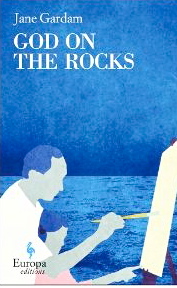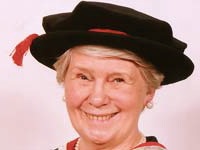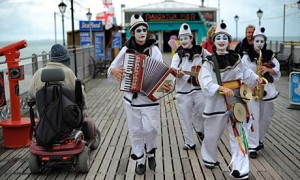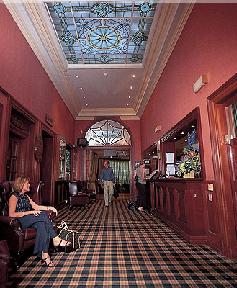Note: Jane Gardam is a WINNER of the Heywood Hall Literary Prize for her lifetime contributions to Literature. She is the only author to have been a two-time WINNER of the Costa (formerly Whitbread) Award. This novel was SHORTLISTED for the Booker Prize in 1978.
“[Marsh] and his wife were members of the Primal Saints [located on Turner Street]…Twice on Sunday and one evening in the week, Marsh’s careful small face was raised to his God and the unlikely loudness of his prayers drowned any noise from the chip shop and the pub round the corner. Not an empty chip bag dared to blow its scratchy way down Turner Street when Marsh was praying for those who preferred to lean on the railings eating their chips rather than contemplate eternity.”
Set in England  in the era between the two world wars, God on the Rocks, with its sly, multi-layered title, is one of Jane Gardam’s earliest novels, a delightful but carefully considered look at society, religion, personal responsibility, and acts of fate in the lives of several families. Eight-year-old Margaret Marsh, the primary speaker, is energetic and thoughtful, living comfortably with her very religious bank manager-father and her subservient and seemingly passive mother. The family has recently been joined, however, by Lydia, a “fallen woman” whom her father Kenneth believes he is called upon to “save.” On Wednesdays, Lydia takes the Bible-spouting Margaret on little trips, and through her, Margaret discovers a world she has never even imagined. Lydia usually abandons Margaret to her own devices shortly after arriving at their destination, often the beach, while Lydia enjoys her own activities with gentlemen she meets there in the woods. Margaret, on her own, has the time of her life.
in the era between the two world wars, God on the Rocks, with its sly, multi-layered title, is one of Jane Gardam’s earliest novels, a delightful but carefully considered look at society, religion, personal responsibility, and acts of fate in the lives of several families. Eight-year-old Margaret Marsh, the primary speaker, is energetic and thoughtful, living comfortably with her very religious bank manager-father and her subservient and seemingly passive mother. The family has recently been joined, however, by Lydia, a “fallen woman” whom her father Kenneth believes he is called upon to “save.” On Wednesdays, Lydia takes the Bible-spouting Margaret on little trips, and through her, Margaret discovers a world she has never even imagined. Lydia usually abandons Margaret to her own devices shortly after arriving at their destination, often the beach, while Lydia enjoys her own activities with gentlemen she meets there in the woods. Margaret, on her own, has the time of her life.
An especially precocious child, Margaret is having a hard time at home, these days, unable to understand the God who has sent her a baby brother who bores her (she wishes she could call him “Scummy,” instead of Terrence), and as she and her mother argue about why Margaret needs to love the baby, Margaret reveals an unusually sophisticated ability to think on two levels—that of her real life, which is infinitely more exciting now that Lydia has arriv ed, and that of the spiritual life which her parents are encouraging in her. As Margaret questions the act of creation on all levels, along with what love really is, she is confused. She has already learned about dinosaurs, which she cannot talk about with her father, and she has concluded that life might have been better without people. “If I’d been God, I’d have left it at dinosaurs. I’d have been satisfied looking down at all that,” she decides. Her mother’s horrified response that God created people in His own image leads Margaret to look at her baby brother, getting his nappies changed. “His own image,” she muses. “If God looks like us…What’s the point?”
ed, and that of the spiritual life which her parents are encouraging in her. As Margaret questions the act of creation on all levels, along with what love really is, she is confused. She has already learned about dinosaurs, which she cannot talk about with her father, and she has concluded that life might have been better without people. “If I’d been God, I’d have left it at dinosaurs. I’d have been satisfied looking down at all that,” she decides. Her mother’s horrified response that God created people in His own image leads Margaret to look at her baby brother, getting his nappies changed. “His own image,” she muses. “If God looks like us…What’s the point?”
Without ever losing her sense of humor, often very dark, Gardam explores the contrasts between “good” and “evil”—the fun that Margaret has with the unrepentant Lydia vs. the predictable boredom that she has with her saintly parents. As Kenneth Marsh begins to wonder what Lydia and Margaret do at the beach (and as Lydia begins to brush suggestively against him at their house), Kenneth decides to accompany them to the beach one Wednesday, using his visit to hold forth on sin, preaching his religion to the vacationers on the beach, a “soapbox bloke.”

Seaside Pierrots, popular in the 1950s
Through flashbacks, Margaret’s early rebellions appear—she played tricks on her parents from early childhood—and as she happily meets “damaged” people at the beach, like Drinkwater, an artist who may be living at the rest home nearby (primarily for the shell shocked), her view of the world also grows. Her mother’s decision to visit Binkie and Charles, old friends from her childhood, expands the novel in many new and exciting directions, simultaneously expanding the thematic focus and the number of points of view. Elinor Marsh’s own childhood and the circumstances under which she married Kenneth Marsh, the point of view of Rosalie Frayling (mother of Charles and Binkie), Rosalie Frayling’s own courtship and marriage, the romantic backgrounds of Binkie and Charles, and the tendency of all people to try to control the vulnerable become subjects of exploration as the novel continues.

An important meeting takes place in the lobby of the Kings Arms Hotel in Cambridge, shown here
Gardam’s ability to describe in the most minute (and perfect) terms the people and places of her novel, and her ability to see the world at large with humor, even as some of her characters cannot avoid seeing the world “writ small,” cannot help but remind older readers (especially) of the enormous contrasts between novels of a previous generation, which were the primary venue for new thematic insights and which were written in precise and carefully considered language, and the present world in which the primary venue is the internet, where the sound bite and the bumper sticker phrase reign. When a “dark and stormy night” brings about the climax, and each of the characters must face a crisis of life-changing dimensions, the author’s sense of irony and dark, mordant humor reach their peak, and reality vs. fantasy, sanity vs. insanity, and religious destiny vs. fate combine with the characters’ identities as we have known them to create a memorable and unforgettable battle among the protagonists and the points of views they represent. Though this is one of Jane Gardam’s early novels, written in 1978 and recently reprinted by Europa Editions, it is in many ways, more light-hearted and more memorable than some of her more famous later novels.
Notes: ALSO by Jane Gardam, reviewed here: THE OLD FILTH TRILOGY: OLD FILTH, THE MAN WITH THE WOODEN HAT, and LAST FRIENDS
Separate novels: THE QUEEN OF THE TAMBOURINE, THE PEOPLE OF PRIVILEGE HILL, CRUSOE’S DAUGHTER, A LONG WAY FROM VERONA THE FLIGHTS OF THE MAIDENS
Photos, in order: The photo of Jane Gardam is from http://www.tees.ac.uk
Regarding the Pierrots: According to Wikipedia, in 1891, the singer and banjoist Clifford Essex returned from France enamored of the Pierrots he had seen there and resolved to create a troupe of English Pierrot entertainers. Thus were born the seaside Pierrots (in conical hats and sometimes black or colored costume) who, as late as the 1950s, sang, danced, juggled, and joked on the piers of Brighton and Margate and Blackpool. The photo here is from www.guardian.co.uk
An important meeting takes place in the lobby of the Kings Arms Hotel in Cambridge, shown here. www.venere.com
